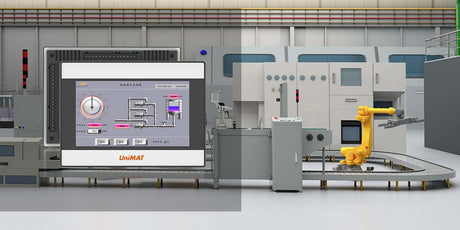
El uso de un microcontrolador para el control requiere circuitos auxiliares, como un oscilador de cristal, un reinicio, una fuente de alimentación y circuitos de entrada y salida. Además de la programación, también necesita hacer su propia placa de circuito, lo que requiere conocimientos profesionales y es incómodo de usar.
En segundo lugar, la programación de ambos es diferente. La programación del microcontrolador requiere lenguaje ensamblador o lenguaje C, que es más difícil. El programa del sistema está solidificado dentro del PLC y solo es necesario utilizar el lenguaje de programación correspondiente. Es fácil de aprender , por lo que la programación es relativamente sencilla.
En tercer lugar, el PLC es un controlador de propósito general compuesto principalmente de microcontroladores, por lo que en términos de precio, el PLC es más caro que los microcontroladores.
Los productos con funciones fijas y grandes cantidades, como instrumentos y electrodomésticos, son adecuados para microcomputadoras de un solo chip, mientras que los controles industriales con funciones muy diferentes son adecuados para PLC.
El ciclo de fabricación de un producto de microordenador de un solo chip es relativamente largo , por lo que es adecuado para productos con funciones fijas y grandes cantidades. El ciclo de fabricación de un PLC es relativamente corto y la aplicación es relativamente flexible. Por lo tanto, el PLC es adecuado para el control industrial en diferentes situaciones.
4. Capacidades de escalabilidad y comunicación
MCU: La escalabilidad de MCU es relativamente limitada y conecta principalmente periféricos como sensores y memoria a través de buses externos (como I2C, SPI, UART, etc.). Aunque se pueden agregar funciones diseñando placas de expansión o módulos, este proceso a menudo requiere un desarrollo personalizado, lo que aumenta la complejidad y el costo del sistema.
PLC: El diseño modular del PLC le otorga una buena escalabilidad. Los usuarios pueden agregar o reemplazar módulos de E/S, módulos de comunicación, etc. según las necesidades reales para lograr una expansión flexible de las funciones. El PLC también admite una variedad de protocolos de comunicación industrial (como Modbus, Profinet, EtherNet/IP, etc.), lo que resulta conveniente para el intercambio de datos y la integración con otros dispositivos o sistemas, y es una parte importante de la construcción de sistemas de control de automatización a gran escala.
Ventajas y desventajas del PLC y MCU:
1. Lenguaje de programación
Los lenguajes de programación de PLC incluyen: lenguaje de diagrama de escalera (LD), lenguaje de lista de instrucciones (IL), lenguaje de diagrama de bloques de funciones (FBD), lenguaje de diagrama de flujo de funciones secuenciales (SFC) y lenguaje de texto estructurado (ST).
Se puede decir que el diagrama de escalera es el más utilizado, porque es un poco como la relación entre la bobina del relé y la acción de descarga eléctrica en el control eléctrico. Si ha aprendido el control del relé-contactor, es mucho más fácil comenzar, por lo que mucho personal de control eléctrico lo elige y es más fácil para los novatos programar con el diagrama de escalera.
El lenguaje de programación de MCU es el lenguaje C o lenguaje ensamblador, y también utiliza su propio lenguaje de programación, como el lenguaje ASM de 51 MCU).
Los códigos de instrucciones de MCU son muchos y complejos, por lo que la programación es más difícil, especialmente cuando se trata de programas de proyectos más complejos, porque no solo se debe entender el inglés sino también el sistema numérico. Las personas con conocimientos básicos de informática pueden ser mejores.
2. Hardware
El MCU generalmente tiene un precio bajo y sus entradas y salidas periféricas son relativamente grandes. Además, el circuito de control del MCU debe ser configurado por el usuario.
La apariencia del PLC parece muy simple, porque su interfaz, fuente de alimentación y circuito antiinterferencia están todos diseñados dentro del PLC, por lo que al aprender y operar, se gasta menos tiempo y energía en el circuito. El objetivo principal es aprender a usar diagramas de escalera para controlar cada puerto de salida. Los diagramas de escalera suelen ser fáciles de usar para principiantes. Y agregar módulos de expansión puede lograr otras funciones, pero el precio del PLC es más caro que el de las microcomputadoras de un solo chip.

Las microcomputadoras de un solo chip y los PLC se pueden utilizar en los campos de la gestión inteligente y el control de procesos de instrumentos y medidores, electrodomésticos, equipos médicos, aeroespaciales y equipos especiales. Las microcomputadoras de un solo chip se pueden seleccionar para el desarrollo de electrónica de consumo, electrónica, juguetes y electrodomésticos para aplicaciones comerciales. Los PLC se pueden seleccionar en los campos de la industria y la agricultura.
En segundo lugar, la microcomputadora de un solo chip es solo un chip, por lo que el circuito es relativamente complejo. Los principiantes a menudo enfrentan problemas como capacidad antiinterferencia débil, distorsión de la señal e interferencia excesiva. El PLC no lo hará.
Lo anterior trata sobre la diferencia entre PLC y MCU. Como fabricante de PLC con más de 20 años de experiencia, el PLC de Unimat puede integrarse sin problemas con el PLC de Siemens, es asequible y ofrece una garantía de tres años. Si necesita un PLC, comuníquese con nosotros.









